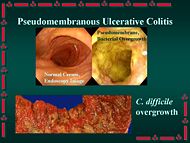Pseudomembranous enterocolitis: Difference between revisions
imported>Robert Badgett |
imported>Robert Badgett (→Antibiotics: Addeed study by Mattila) |
||
| Line 33: | Line 33: | ||
====Antibiotics==== | ====Antibiotics==== | ||
Observational [[cohort study|studies]] conflict regarding the best agent and suggest [[vancomycin]] may<ref name="pmid12135033">{{cite journal |author=McFarland LV, Elmer GW, Surawicz CM |title=Breaking the cycle: treatment strategies for 163 cases of recurrent Clostridium difficile disease |journal=Am. J. Gastroenterol. |volume=97 |issue=7 |pages=1769–75 |year=2002 |month=July |pmid=12135033 |doi=10.1016/S0002-9270(02)04195-3 |url= |issn=}}</ref> or may not<ref name="pmid16477549">{{cite journal |author=Pépin J, Routhier S, Gagnon S, Brazeau I |title=Management and outcomes of a first recurrence of Clostridium difficile-associated disease in Quebec, Canada |journal=Clin. Infect. Dis. |volume=42 |issue=6 |pages=758–64 |year=2006 |month=March |pmid=16477549 |doi=10.1086/501126 |url=http://www.journals.uchicago.edu/doi/abs/10.1086/501126?url_ver=Z39.88-2003&rfr_id=ori:rid:crossref.org&rfr_dat=cr_pub%3dncbi.nlm.nih.gov |issn=}}</ref> be better than [[metronidazole]]. Various methods exist for the administration of [[vancomycin]]<ref name="pmid12135033">{{cite journal |author=McFarland LV, Elmer GW, Surawicz CM |title=Breaking the cycle: treatment strategies for 163 cases of recurrent Clostridium difficile disease |journal=Am. J. Gastroenterol. |volume=97 |issue=7 |pages=1769–75 |year=2002 |month=July |pmid=12135033 |doi=10.1016/S0002-9270(02)04195-3 |url= |issn=}}</ref><ref name="pmid4050760">{{cite journal |author=Tedesco FJ, Gordon D, Fortson WC |title=Approach to patients with multiple relapses of antibiotic-associated pseudomembranous colitis |journal=Am. J. Gastroenterol. |volume=80 |issue=11 |pages=867–8 |year=1985 |month=November |pmid=4050760 |doi= |url= |issn=}}</ref> | Observational [[cohort study|studies]] conflict regarding the best agent and suggest [[vancomycin]] may<ref name="pmid12135033">{{cite journal |author=McFarland LV, Elmer GW, Surawicz CM |title=Breaking the cycle: treatment strategies for 163 cases of recurrent Clostridium difficile disease |journal=Am. J. Gastroenterol. |volume=97 |issue=7 |pages=1769–75 |year=2002 |month=July |pmid=12135033 |doi=10.1016/S0002-9270(02)04195-3 |url= |issn=}}</ref> or may not<ref name="pmid16477549">{{cite journal |author=Pépin J, Routhier S, Gagnon S, Brazeau I |title=Management and outcomes of a first recurrence of Clostridium difficile-associated disease in Quebec, Canada |journal=Clin. Infect. Dis. |volume=42 |issue=6 |pages=758–64 |year=2006 |month=March |pmid=16477549 |doi=10.1086/501126 |url=http://www.journals.uchicago.edu/doi/abs/10.1086/501126?url_ver=Z39.88-2003&rfr_id=ori:rid:crossref.org&rfr_dat=cr_pub%3dncbi.nlm.nih.gov |issn=}}</ref> be better than [[metronidazole]]. Various methods exist for the administration of [[vancomycin]]<ref name="pmid12135033">{{cite journal |author=McFarland LV, Elmer GW, Surawicz CM |title=Breaking the cycle: treatment strategies for 163 cases of recurrent Clostridium difficile disease |journal=Am. J. Gastroenterol. |volume=97 |issue=7 |pages=1769–75 |year=2002 |month=July |pmid=12135033 |doi=10.1016/S0002-9270(02)04195-3 |url= |issn=}}</ref><ref name="pmid4050760">{{cite journal |author=Tedesco FJ, Gordon D, Fortson WC |title=Approach to patients with multiple relapses of antibiotic-associated pseudomembranous colitis |journal=Am. J. Gastroenterol. |volume=80 |issue=11 |pages=867–8 |year=1985 |month=November |pmid=4050760 |doi= |url= |issn=}}</ref> and [[metronidazole]]<ref name="pmid19086244">{{cite journal |author=Mattila E, Anttila VJ, Broas M, ''et al'' |title=A randomized, double-blind study comparing Clostridium difficile immune whey and metronidazole for recurrent Clostridium difficile-associated diarrhoea: efficacy and safety data of a prematurely interrupted trial |journal=Scand. J. Infect. Dis. |volume=40 |issue=9 |pages=702–8 |year=2008 |pmid=19086244 |doi= |url= |issn=}}</ref>. | ||
{| class="wikitable" | {| class="wikitable" | ||
| Line 44: | Line 44: | ||
|- | |- | ||
|Metronidazole pulsed regimen<ref name="pmid16477549"/>||7 patients||1.0 to 1.5 grams per day<br/>10 - 14 days||align="center"|NA||37% | |Metronidazole pulsed regimen<ref name="pmid16477549"/>||7 patients||1.0 to 1.5 grams per day<br/>10 - 14 days||align="center"|NA||37% | ||
|- | |||
|Metronidzole constant dose<ref name="pmid19086244">||20 patients||Metronidzole 1200 mg daily<br/>14 days||align="center"|NA||45% | |||
|- | |- | ||
| Vancomycin constant dose<ref name="pmid12135033"/>||83 patients||0.5 to 3 grams/day<br/>10 - 16 days||align="center"|NA||54% | | Vancomycin constant dose<ref name="pmid12135033"/>||83 patients||0.5 to 3 grams/day<br/>10 - 16 days||align="center"|NA||54% | ||
Revision as of 00:28, 12 February 2009
| Pseudomembranous enterocolitis | |
|---|---|
| Pseudomembranous enterocolitis | |
| MeSH | D004761 |
In medicine, pseudomembranous enterocolitis is an "acute inflammation of the intestinal mucosa that is characterized by the presence of pseudomembranes or plaques in the small intestine (pseudomembranous enteritis) and the large intestine (pseudomembranous colitis). It is commonly associated with antibiotic therapy and clostridium difficile colonization."[1]
Epidemiology
About 50% of patients with diarrhea after antibiotics that is severe enough to be admitted to the hospital have pseudomembranes on colonoscopy.[2]
Diagnosis
Sigmoidoscopy has a sensitivity of 31% in detecting pseudomembranes as compared to colonosopy.[3]
Treatment
Antibiotics
Various antibiotics have been studied in randomized controlled trials.[4][5][6] Teicoplanin may be the most effective antibiotic.[4][5] Vancomycin has an insignificant trend towards being better than metronidazole.[4]
Administration of bacteria
Probiotic administration may[7] or may not [8]help according to a meta-analyses and a more recent randomized controlled trial.[9] However, probiotics can be harmful among intensive care patients.[10]
Recurrent infection
A clinical prediction rule found that recurrent infection is more likely if age is more than 65 years, the patient has severe or fulminant illness, and additional antibiotic exposure occurs after after treatment of the initial Clostridium difficile infection.[11] Use of antacids may also be a risk factor for recurrence.[12]
Asymptomatic carriage should not be treated according to a meta-analysis.[13]
Antibiotics
Observational studies conflict regarding the best agent and suggest vancomycin may[14] or may not[15] be better than metronidazole. Various methods exist for the administration of vancomycin[14][16] and metronidazole[17].
| Patients | Intervention / duration | Comparison | Outcome Recurrence rate | |
|---|---|---|---|---|
| Approximately 2 weeks | ||||
| Vancomycin pulsed regimen[15] | 7 patients | 0.5 to 2 grams daily 10 - 14 days |
NA | 40% |
| Metronidazole pulsed regimen[15] | 7 patients | 1.0 to 1.5 grams per day 10 - 14 days |
NA | 37% |
Metronidzole constant doseCite error: Closing </ref> missing for <ref> tag
Administration of bacteriaProbiotics may help.[18] However, probiotics can be harmful among intensive care patients.[10] Rectal infusion of feces helped according to case reports.[19][20] References
|
||||
